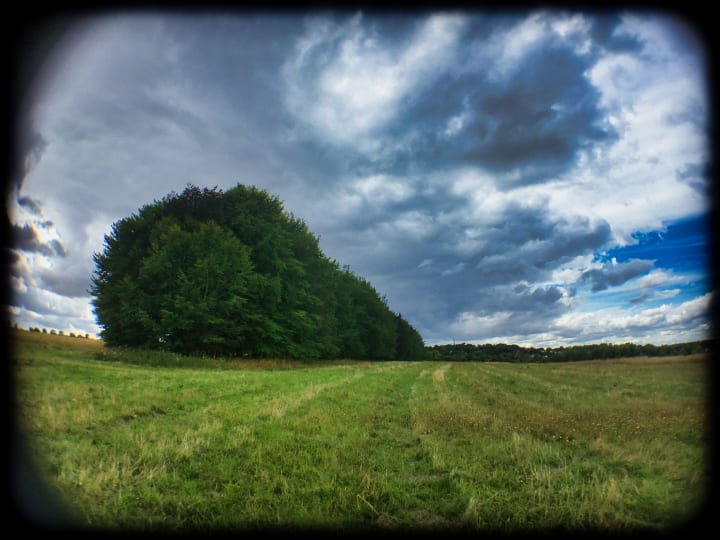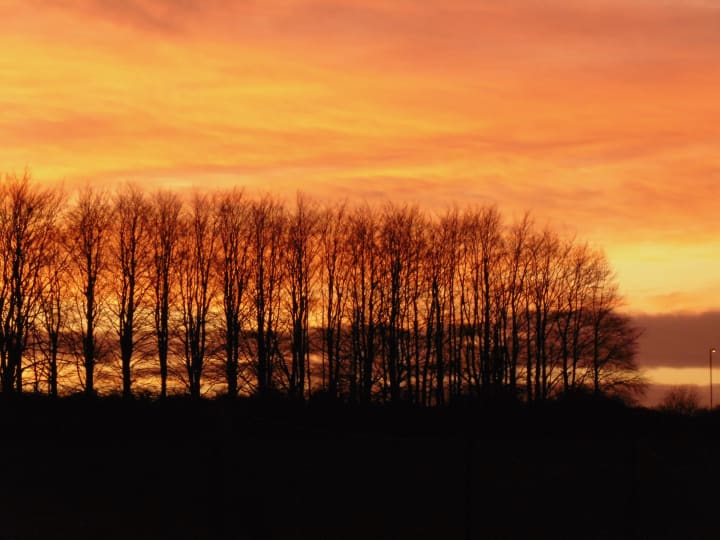
A short stretch of tarmac path curves away from the mock-ochre–brick houses perched on a low ridge. The path is at the far corner of a suburban estate of new-builds. A parade of low streetlights follows the path and peters out into the ragged fringes of development; the dog-walkers’ fields, the urban scrub and hinterland of an ancient city.
Beyond what we call the ‘top path’, lies a loaf-shaped, sixty-acre, wild field that the children call the ‘top field’. The field is largely the domain of a few hobbled Romany horses, some fly-tipped heaps of hardcore and a seemingly permanent, though peripatetic, burnt patch from a recent bonfire.
I’ve made it sound partly dismal - at least semi-liminal - in that urban waste ground way of psycho-geographers. But, before, during and I dare say, after, lockdown, it has been a blessing.

In spring and summer under an arching blue sky, where larks sing like clockwork toys, buttercup clumps and rough turf dominate the landscape. On the landscape’s crest, a narrow, die-straight belt of beech and copper beech march to the centre of the field where parish boundary, bridleway and desire-line paths run. Strictly speaking, this is not open access land, except that it is owned by the local authority, twenty-four years after a relief road was meant to be built over it. The road was never built. There's even a plaque to celebrate this achievement.

So now, on autumn days, instead of grid lock and car fumes, there are soft breezes and the scent of hay. From September, the skylarks still whirr high into the sky, singing their automata hearts out in the Indian Summer sunshine. The beech leaves grow as rusty as those on their copper beech neighbours and eventual fall to line the woodland path with a deeply satisfying crunch and crackle.

An early winter storm blows the trees bare and silhouettes dominate the landscape. Rich red stalks of dogwood and teasels start to fringe the southern edges of the sixty acre field. A tangle of thorn and salix scrub marks the northern end where it divides the top field from a suburban link road. Abandoned children's dens - perhaps the outcome of a happy afternoon in summer - become apparent as the wind rips the cover from the trees.

Hoar frosts come in December and crystallize on the heads of teasels as if they were Christmas decorations. Snow comes after Christmas and the world is turned on its head. Landscape becomes new again; reduced to the absolute essentials of form, the land gives up all the secret humps and hummocks normally obscured by the living details of spring, summer and autumn. You suddenly find all the grand lines that make the lie of the land what it is.


I have lived near the sixty-acre field for a dozen years, for the last six of those years the field has been my next door neighbour. I live here with my wife and two children, around a mile south of the City of Salisbury in the UK. Before we moved here, my wife had driven through once and I had only visited, briefly, on three occasions. The first time was as a hitchhiker making my way to the west country. The second was on a milk float for the book Three Men in a Float and my final visit was to view property.
It feels like home, and the field feels like an untidy, annexed garden. From the top field, you can see the 404 foot spire of Salisbury Cathedral, a mile to the north. It dominates everything. Wherever you go in the city, the cathedral makes itself known. Indeed, if Salisbury has a genius loci - a prevailing spirit of place - the cathedral would be its most significant manifestation.
Like many old churches, it certainly has an aura about it - a secondary effect, perhaps, of its age, volume and scale as well as the way architecture resonates in the space it inhabits. But there's something else about the place that defies both rational explanation and the monotheistic medieval world view that brought it into being. It is beautiful, but wholly unreasonable.

Its presence here, even through the haze of a soft summer drizzle that falls in the top field, is as an apparition that defies the scale of the foreground. Almost anywhere you go in the city, you are within a moment of a view of it.
The Cathedral sits in its own field, the eighty-acre Cathedral Close - the term ‘close’ is from an old French word ‘clos’ for enclosure, used here as meaning the precinct of a cathedral, but also as a word for lowly, non-sacred fields in general. I've always felt, with little evidence, that the road name ‘close’ - for a cul-de-sac - came from. My intuition is that the tiny streets that service neat, new developments may have taken their names from the wild and untidy fields they tarmaced over.
Much the same will happen to our sixty-acre field. There’s a clue in that it was once a ninety-acre field. A new development between here and the trees will spring up soon and with it, more families will get to know this place, this new fifty-acre field, as close to home.
About the Creator
Ian Vince
Erstwhile non-fiction author, ghost & freelance writer for others, finally submitting work that floats my own boat, does my own thing. I'll deal with it if you can.






Comments
There are no comments for this story
Be the first to respond and start the conversation.